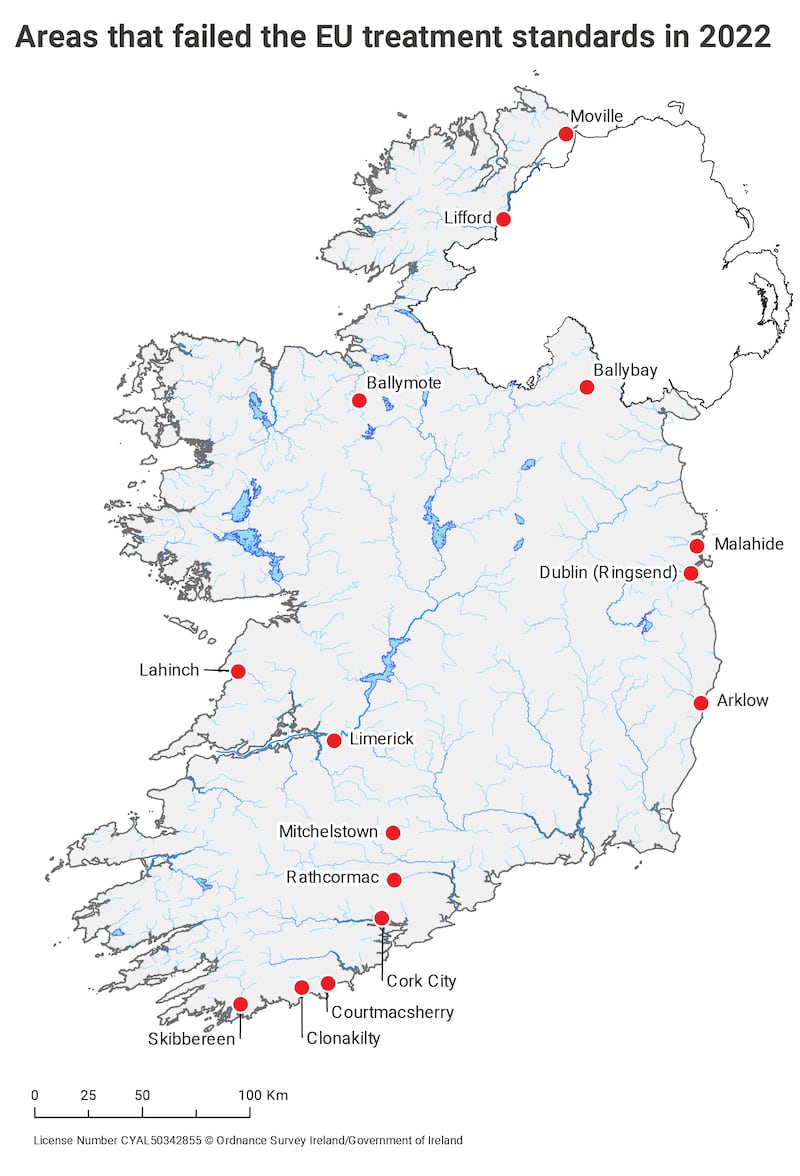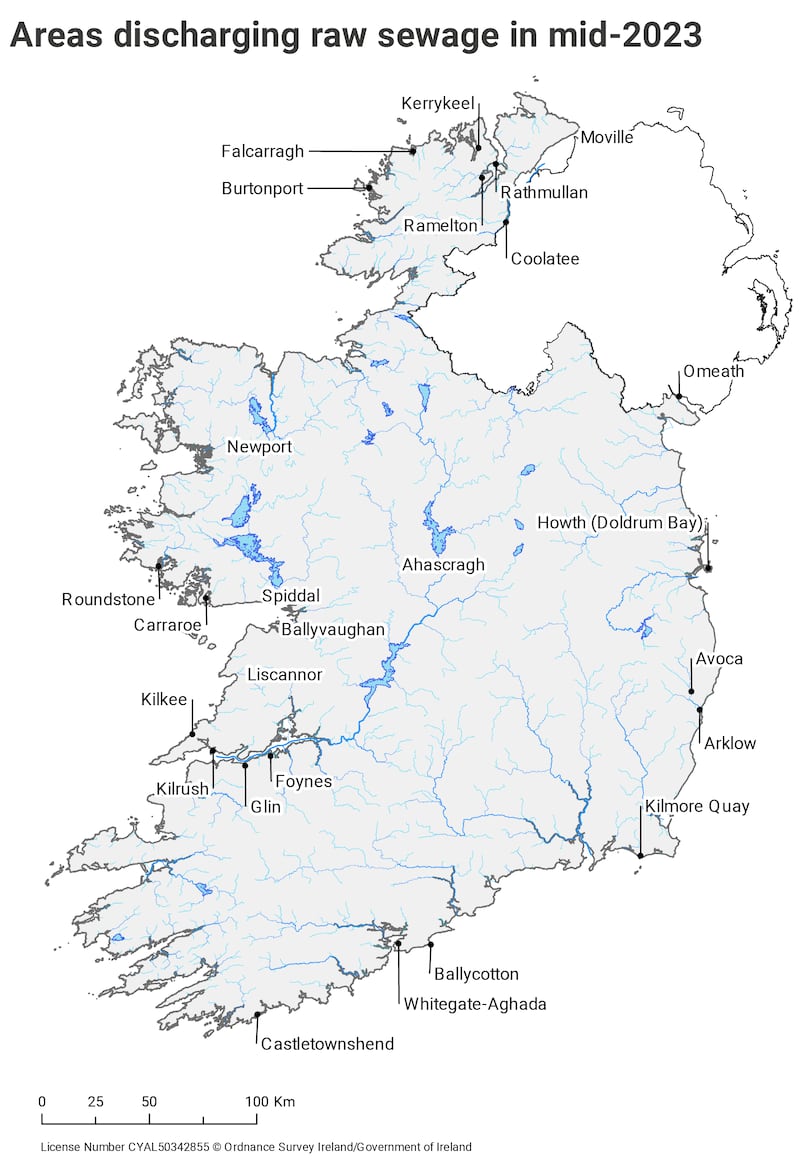Over half of Ireland’s wastewater discharges are not meeting EU standards set to protect the environment, including facilities for the population centres of Dublin and Cork, according to an Environmental Protection Agency report that is highly critical of Uisce Éireann.
The utility “still does not have clear plans to prevent pollution at some of the most significantly impacted water bodies, and it is vital these are resolved through its new investment plan”, the EPA concludes in its 2022 urban wastewater treatment report.
Uisce Éireann’s new investment plan must “end pollution of our rivers and coastal waters from wastewater”, it adds, and where modern treatment plants are installed, they must be operated and maintained properly.
It has committed to eliminating raw sewage discharges by 2025 from the majority of 26 towns and villages with no treatment and “is making progress with the connection of six villages to new treatment plants”, the EPA says.
RM Block

However, raw sewage from the equivalent of 54,000 people in 26 towns and villages is still discharged into the environment every day because these areas are not connected to treatment plants. “The volume of raw sewage discharged daily could fill three Olympic size swimming pools,” the report adds.
Wastewater continues to harm the quality of many of Ireland’s rivers, estuaries, lakes and coastal waters. While some works to upgrade treatment plants are progressing, Uisce Éireann’s delays in other areas “are prolonging the risks to the environment and public health”.
EPA director Dr Tom Ryan said: “While it is encouraging to see continued progress in stopping the unacceptable practice of discharging raw sewage into our environment, wastewater remains a significant pressure on Ireland’s water ways and is adversely impacting water quality. The pace at which Uisce Éireann is delivering improvements needs to accelerate to prevent pollution and protect water quality.
“Uisce Éireann must take the opportunity of its new investment plan for 2025 to 2029 to deliver wastewater infrastructure that meets the needs of our society and protects and improves our environment into the future. [It] must prioritise resources to prevent pollution in the priority areas highlighted by the EPA.”

Thirty years after Ireland was required to bring provisions into force to comply with EU treatment standards, less than half (45 per cent) of wastewater is compliant. This is expected to improve significantly to over 90 per cent when the upgrade of Ireland’s largest treatment plant at Ringsend beside Dublin Bay is complete, the EPA says.
EPA programme manager Noel Byrne said: “It is welcome that Uisce Éireann is currently building infrastructure at large urban areas, including Ringsend and Arklow ... However, poor management practices at upgraded plants, such as Skibbereen and Courtmacsherry, caused inadequately treated sewage to discharge into the environment.”
This was not acceptable as these plants had sufficient treatment capacity, he said. Uisce Éireann must implement effective maintenance programmes for existing infrastructure and improve its operation and management of treatment plants to prevent such failures in future, he added.
Breakdowns at treatment plants have increased each year since 2019. There were 360 breakdowns reported in 2022, an increase of 84 per cent on 2019. One breakdown was the failure of pumps needed to control “activated sludge” within a treatment plant. This affected the plant’s performance and resulted in discharges of poorly treated effluent into a river.
Uisce Éireann welcomed the finding that progress was being made in tackling long-running issues, notably raw sewage discharges.
“2022 saw the highest annual investment in wastewater to date of over €450m as Uisce Éireann continues to make progress in priority areas such as locations where there is raw sewage entering the rivers, lakes and the sea – sites identified by the European Court of Justice ... and sites where urban wastewater is a significant pressure,” it added.
Uisce Éireann’s head of infrastructure delivery, Brian Sheehan, said: “Ending raw sewage discharges and improving wastewater treatment for cities, towns and villages across the country are priorities for Uisce Éireann. We are making huge strides ... and we are now seeing real and tangible benefits from the unprecedented level of investment in this essential infrastructure.”
Last year it had invested more than €1bn in water and wastewater projects, “and we will need to maintain this level of funding in the years to come” he said, adding that it was also necessary to address existing issues in the planning and approvals system “so large-scale critical infrastructure can progress within a reasonable time frame”.
The report is available at www.epa.ie.
Wastewater problems needing attention
It will take a multibillion-euro investment, and at least two decades, to bring wastewater treatment systems up to the standard needed to protect the environment, the EPA says, and to meet future needs.
As all the problems cannot be fixed in the short term, the EPA says Uisce Éireann must direct available resources to areas where they are needed most and bring the greatest benefits.
The EPA identifies the following priority areas:
• 26 towns and villages discharging raw sewage daily in mid-2023 – though new treatment plants have since been completed at Kerrykeel, Co Donegal, and Liscannor, Co Clare.
• 15 large towns and cities where wastewater treatment failed to meet EU standards. These include the Greater Dublin Area, served by an overloaded plant at Ringsend; Limerick; Lahinch, Co Clare; and Skibbereen and Clonakilty in Co Cork.
• 39 areas where wastewater is adversely impacting the quality of rivers, estuaries, lakes and coastal waters. Uisce Éireann “is taking far too long to design and start delivering the improvements needed at many (28) of these areas”.
• 12 towns and villages where wastewater treatment must improve to protect freshwater pearl mussels. Failure to advance works at half of these areas is prolonging risks to these endangered species.
• 6 large towns and cities where collecting systems (sewers) must be upgraded to protect the environment and address the findings of a 2019 judgment from the EU Court of Justice.














